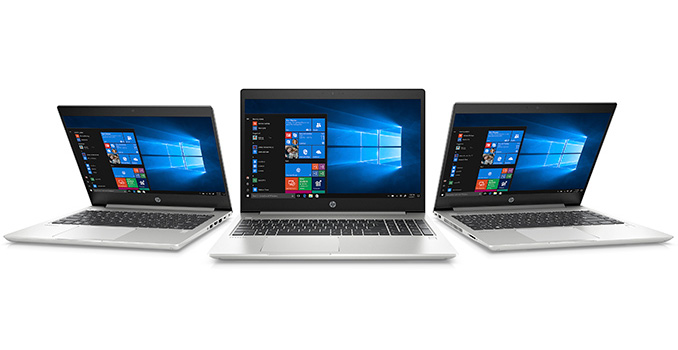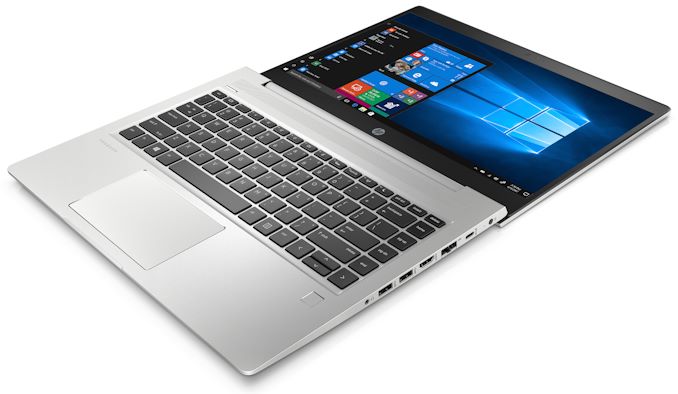HP Launches ProBook 400 G6 Series: Thinner & Sleeker Workhorses
by Anton Shilov on November 28, 2018 9:00 AM EST
HP on Wednesday introduced its sixth-generation ProBook 400-series laptops, which are aimed at small and medium businesses. Just like their direct predecessors, the new HP ProBook 400-series G6 systems are powered by Intel’s 8th Generation Core i3/i5/i7 "Whiskey Lake" processors. Meanwhile, the new notebooks come in sleeker and thinner aluminum chassis and generally look better than the laptops they're set to replace.
HP’s ProBook 400-series G6 are typical workhorses that bring together stylish looks, regular weight and thickness, moderate specs, as well as robust security. The latter is enabled by a TPM 2.0 chip, HP’s BIOSphere Gen4 firmware, a fingerprint reader, and an optional Windows Hello-compatible webcam with IR sensors. Though it should be noted that since the ProBook 400-series are not enterprise-grade machines, HP does not offer things like SEDs (self-encrypting drives), remote management, etc. At the same time, select models will be outfitted with Intel’s XMM 4G/LTE Cat 6 or Cat 9 modems to please road warriors. As an added bonus, all the ProBook 400 G6 notebooks also use a spill-resistant keyboard.
The new ProBook 400-series G6 machines come in aluminum chassis with 13.3, 14, and 15.6-inch displays that appear to be a bit thinner and lighter when compared to ProBook 400-series G5 machines. Speaking of monitors, they feature a 1920×1080 or 1366×768 resolution and may be covered with an antiglare coating. As for weight and thickness, they vary from 1.5 to 2 kilograms as well as from 1.8 to 1.9 cm (see the table below for exact details).
When it comes to internal hardware, HP’s ProBook 400-series G6 notebooks are based on Intel’s dual-core and quad-core 8th Generation Core i3/i5/i7 processors featuring the Whiskey Lake microarchitecture that are paired with up to 32 GB of DDR4-2400 memory. Storage options are either a full SSD or a hard drive paired with Intel’s 16 GB Optane Memory storage cache. HP also says that select SKUs will be offered with a discrete NVIDIA GeForce GPU, but does not provide any exact details on the matter.
On the connectivity side of things, HP’s new ProBook 400-series G6 laptops offer a rather typical set of technologies, including 802.11ac Wi-Fi, a GbE port, an HDMI 1.4b output, an SD card slot, USB 3.0 Type-A and Type-C ports, a TRRS audio jack, and so on.
Being regular workhorses, HP’s ProBook 430 G6, ProBook 440 G6, and ProBook 450 G6 notebooks are not intended to offer any specific technological breakthroughs, but rather a combination of capabilities tailored for small and medium businesses that comes at a right price. Speaking of the latter, HP’s ProBook 400-series G6 laptops will be available this month starting at $589.
| General Specifications of HP's ProBook 400 G6 Laptops | |||||
| ProBook 430 G6 |
ProBook 440 G6 |
ProBook 450 G6 |
|||
| Display | Diagonal | 13.3" | 14" | 15.6" | |
| Resolution, Type | 1920×1080 IPS 1920×1080 IPS AG* 1366×768 SVA 1366×768 SVA AG* |
1920×1080 IPS AG* 1366×768 SVA 1366×768 SVA AG* |
|||
| Brightness | 220 cd/m² | ||||
| Color Gamut | 67% sRGB | ||||
| CPU** | Intel Core i7+ 8565U: 4C/8T, 1.8 - 4.6 GHz, 8 MB | 16 GB Intel Optane Intel Core i5+ 8265U: 4C/8T, 1.6 - 3.9 GHz, 6 MB | 16 GB Intel Optane Intel Core i7-8565U: 4C/8T, 1.8 - 4.6 GHz, 8 MB Intel Core i5-8265U: 4C/8T, 1.6 - 3.9 GHz, 6 MB Intel Core i3-8145U: 2C/4T, 2.1 - 3.9 GHz, 4 MB |
||||
| GPU | Intel UHD Graphics 620: 24 EUs (192 shading units), 300 - 1000/1150 MHz Optional NVIDIA GeForce dGPU*** |
||||
| RAM | Up to 32 GB DDR4-2400 | ||||
| Storage | 1 TB 5400 rpm SATA 500 GB 7200 rpm SATA 128 GB up to 256 GB M.2 SATA SSD 256 GB up to 512 GB PCIe NVMe M.2 SSD |
||||
| Wireless | Realtek RTL8821CE 802.11ac (1x1) Wi-Fi + Bluetooth 4.2 Realtek RTL8822BE 802.11ac (2x2) Wi-Fi + Bluetooth 4.2 Intel Wireless-AC 9560 802.11ac (2x2) Wi-Fi + Bluetooth 5 non-vPro Intel XMM 7360 LTE-Advanced Cat 9 Intel XMM 7262 LTE-Advanced Cat 6 |
||||
| USB | Type-A | 2×USB 3.0 Type-A | 3×USB 3.0 Type-A | ||
| Type-C | 1 × USB 3.1 Gen 1 Type-C (power, data, DP 1.2) | ||||
| Display Output | HDMI 1.4b | ||||
| Ethernet | GbE | ||||
| Webcam | 720p webcam 720p webcam with IR sensors |
||||
| Other I/O | TRRS connector for audio, speakers, microphone, SD card reader, power connector | ||||
| Keyboard | HP Premium spill-resistant keyboard | ||||
| Figerprint Reader | Yes | ||||
| Security | discrete TPM 2.0 chip | ||||
| Battery (capacity | life) | 45 Wh | 14 hours | 45 Wh | 13.25 hours | 45 Wh | 12.5 hours | ||
| Dimensions | Width | 30.85 cm | 12.15 inch | 32.42 cm | 12.76 inch | 36.49 cm | 14.37 inch | |
| Length | 23.1 cm| 9.09 inch | 23.77 cm | 9.36 inch | 25.69 cm | 10.11 inch | ||
| Thickness | 1.8 cm | 0.71 inch | 1.8 cm | 0.71 inch | 1.9 cm | 0.75 inch | ||
| Weight | 1.49 Kg | 3.28 Lbs | 1.6 Kg | 3.53 Lbs | 2 Kg | 4.41 Lbs | ||
| Operating System | Windows 10 Pro 64 Windows 10 Pro (National Academic only) Windows 10 Home 64 Windows 10 Home Single Language 64 FreeDOS 3.0 |
||||
| Price | ? | ? | ? | ||
| Notes | *AG = antiglare **HP's specifications published on its website list too high base frequencies for Intel's CPUs. We ***HP does not disclose which NVIDIA GeForce GPUs it plans to offer |
||||
Related Reading:
- HP Announces ProBook x360 440 G1 Notebook: Slim and Secure Convertible
- HP Unveils EliteBook 700 G5, ProBook 645 G4 Laptops with Ryzen PRO [UPDATED]
- HP Launches EliteBook x360 1040 G5: Now with 14-Inch Display and 32 GB of RAM
- HP Unveils EliteBook x360 1030 G3 Convertible: Quad-Core CPU, 700-Nits LCD, 18 Hrs
Source: HP


























10 Comments
View All Comments
DanNeely - Wednesday, November 28, 2018 - link
I really have trouble combining "workhorse" and "15W dual core". Yeah, they won't throttle as badly as the 5W models, but only 2 physical cores isn't a lot for anything that's computationally intensive and 15W still means that sustained performance is much lower than burst.tmanini - Wednesday, November 28, 2018 - link
It think the analogy is meant to pertain to the worker. A workhorse gets the job done, day in and day out... chugging along. A thoroughbred wins the races.DanNeely - Wednesday, November 28, 2018 - link
I think your horse analogy is backwards. A thoroughbread race horse is low TDP chip that can win a race by being really fast for a short period before thermal throttling and slowing massively. The workhorse is the chip with a higher sustained TDP/clockspeed that can keep going at its target speed all day long.benedict - Wednesday, November 28, 2018 - link
Those thin monstrocities are anything but "workhorses". Unless all you do at work is browse the web. Ask them to do any real work and they throttle immediately and the laptop gets awfully hot.Samus - Wednesday, November 28, 2018 - link
That’s why I ended up with a Dell Latitude 5290. It’s a bulky 12.5” laptop with a pretty low res PVA screen, but it rarely throttles. I was testing security system with 11 4K camera feeds recording to Blue Iris with Intel Quicksync and it ran 4c 8t above 3ghz for 15 minutes straight. It got loud but it worked wonderful, and the machine is still figuratively small. Being able to cram a decent size blower into a laptop that has sufficient surface area for a copper heat sink is key more than ever with coffee lake.jeremyshaw - Wednesday, November 28, 2018 - link
One can do, say, video editing on a 15W CPU. I've done it recently. That's because in a lot of well designed laptops, the "15W" quadcores are allowed to draw around 25-30W continuously, which is really closer to allowing 3GHz+ all core turbo.That being said, the lackluster specs on this laptop don't show much promise. Low gamut display, base 1366x768 option, but no dock to counterbalance it, I'd bet against the Nvidia GPU being a MX150, in favor of a much older MX130.
At least HP has finally stopped shifting the KB to the left on the 13.3" model.
TheinsanegamerN - Wednesday, November 28, 2018 - link
A 15 watt dual core with nvidia MX150 would be great for a portable mini gaming machine, but far from "workhorse" specs.wintermute000 - Tuesday, December 4, 2018 - link
It would basically be an indie/e-sports machine, which is all well and good, but unless you really love MOBAs/Fortnite/Overwatch etc. you're probably better off with a much cheaper switch or ipad. These won't be cheap, if the primary use is gaming I'd rather be stepping up to at least a 1050 class GPU for that price.
Dragonstongue - Wednesday, November 28, 2018 - link
I will also jump on other folks saying "workhorse"IMO spec alone says "sure" one can consider them so because the resolution etc is anything but "awesome"CPU wise are "par for the course" in 2018, SSD and memory options are "reasonable" because likely HP being who they are the moment they attach name "pro" drives cost up even when the specs are not really "pro"
the one single thing IMO that holds back that analogy if THEY are the ones using it is that small arse battery, yes there are worse but more often than not their way of "rating" leaves much to be desired (reduce brightness etc) 45Wh is "ok" for sure, but "workhorse" in my opinion is a horse that can do heavy work without stopping for many hours at a time, I do not see this being the case due to extra thin (likely means thermal issues) and so so battery size (with likely not any way to expand it...HP forte..part of the reason I detest most laptop designs these days, cookie cutter designs where they jack hefty price on them but cut down battery sizes because they use "efficient" components...I want both, hefty performance AND battery ^.^)
jaydee - Friday, November 30, 2018 - link
How much money can they possibly be saving by going with the 1366×768 panels on the base models at this point?